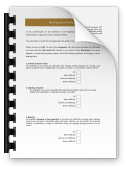How is the GPI coded?
The respondent indicates his/her health state by ticking in the box against the most appropriate statement in each of the five dimensions. The level of difficulty is coded as 1-4 according to increasing levels of difficulty. Only one response to each dimension is required.
Examples
1: Central and near vision
For example, do you have any difficulties with reading, writing watching TV, sewing, card games, compute work, reading dials on cookers on clocks or any activities similar to these?

2: Lighting and glare
For example, do you have any difficulties adjusting from light to dark and vice-versa), dazzle from bright lights, or difficulties seeing in dim light?

3: Mobility
For example, because of your eyesight, do you have any difficulties crossing roads, walking along busy pavements, negotiating steps and kerbs, tripping over low objects (for example children in pushchairs or dogs) or difficulties driving (or stopping driving) because of your vision?

4: Activities of daily living
For example, because of your eyesight, do you have you any difficulties with domestic, DIY or self-care tasks around the home? This category includes difficulties pouring liquid into containers (e.g. water into a glass), problems judging shelf height leading to difficulties putting objects into or retrieving them from cupboards, being unaware of open cupboard doors and similar problems.

5: Eye discomfort
For example, any difficulties because one or both eyes feeling gritty, sore, or tired?

6: Other possible effects of glaucoma or its treatment
For example, do you experience a dry mouth or a bitter after taste, fatigue, shortness of breath or difficulties with sexual functioning?

This health state is coded as 233342
How is the GPI scored?
Missing data are coded as 9. If two responses are recorded for one dimension these are coded as missing. If any of the six dimensions are missing the GPI score is missing. A summary GPI score could be calculated on a likert scale as a glaucoma specific health profile. However, the instrument was designed to provide a Utility score the Glaucoma Utility Index (GUI).
Generating quality weights for a GPI health state
Using a discrete choice experiment (DCE), preferences for each possible health state were estimated from 289 respondents with glaucoma. The responses were analysed to estimate an algorithm such that the utility weights could be estimated for all health states within the GPI. Detailed methods are provided in the associated publication.1 Utility weights were calculated by summation of the coefficients associated with the best level for each dimension. The weights for all other levels of each dimension were then estimated as a proportion of this score, allowing all combinations to be estimated on a 0 to 1 scale while maintaining the ratio between the comparisons, see table 1.
Table 1: Quality weights for the Glaucoma Utility Index
| Dimension | Index* | Dimension | Index* |
|---|---|---|---|
| Central and near vision No difficulty Some difficulty Quite a lot Severe | 0.322 0.219 0.135 0 | Activities of daily living No difficulty Some difficulty Quite a lot Severe | 0.257 0.185 0.111 0 |
| Lighting and glare No difficulty Some difficulty Quite a lot Severe | 0.070 0 0 0 | Eye discomfort No difficulty Some difficulty Quite a lot Severe | 0.062 0.035 0.035 0 |
| Mobility No difficulty Some difficulty Quite a lot Severe | 0.237 0.148 0.090 0 | Other effects No difficulty Some difficulty Quite a lot Severe | 0.052 0.043 0.043 0 |
*When using DCEs to assess utility scores within a QALY framework, issues arise with anchoring on a 0 to 1 scale. To ensure the best level of all dimensions resulted in a score of ‘1’ quality weights were calculated by summation of the coefficients associated with the best level for each dimension. The weights for all other levels of each dimension were then estimated as a proportion of this score, allowing all combinations to be estimated on a 0 to 1 scale while maintaining the ratio between the comparisons.
Utility scores for examples of GPI health states
| Situation description | Quality weights | Utility Score |
|---|---|---|
| You have no difficulty with central and near vision, You have no difficulty with lighting and glare, You have no difficulty with mobility, You have no difficulty with activities of daily living, You have no difficulty with local eye discomfort You have no difficulty with other effects of glaucoma and its treatment | 0.322 0.070 0.237 0.257 0.062 0.052 | 1 |
| You have some difficulty with central and near vision You have no difficulty with lighting and glare You have no difficulty with mobility You have no difficulty with activities of daily living You have no difficulty with local eye discomfort You have no difficulty with other effects of glaucoma and its treatment | 0.219 0.070 0.237 0.257 0.062 0.052 | 0.897 |
| You have some difficulty with central and near vision, You have some difficulty with lighting and glare, You have some difficulty with mobility, You have no difficulty with activities of daily living, You have no local eye discomfort You have no difficulty with other effects of glaucoma and its treatment | 0.219 0 0.148 0.257 0.062 0.052 | 0.737 |
| You have severe difficulty with central and near vision, You have severe difficulty with lighting and glare, You have severe difficulty with mobility, You have severe difficulty with activities of daily living, You have severe difficulty with local eye discomfort and You have severe difficulty with other effects of glaucoma and its treatment | 0 0 0 0 0 0 | 0 |
Automated GUI score
We have developed a ‘Do file” enabling an utility score to be calculated.
Users are welcome to download the do file attached and run it with a Stata command prompt or their own ‘do files/programs’. In brief this will:
Take a list of the 6 dimensions, ordered according to the GPI instrument, assume that variables are correctly coded 1 through 4 and generate the score in a variable called guindex.
The program will stop if
- a) There are more than or less than six variables listed
- b) Any of the six variables included are not numerical
- c) Any value in any of the variables is not a 1 2 3 or 4.
It will also set the overall GUI score to missing for a case if any of the six items are missing. Errors are displayed for a) through to c), a reminder is included at the end regarding missing data. The program also displays a reminder at the end about the correct order of the variables relating to the order of variables in the questionnaire and values that should have been used (1= no difficulty etc.)
An example is:
guindex nearvision lightingandglare mobility dailyliving eyediscomfort effectofglaucoma
Publications:
- Burr JM, Kilonzo M, Vale L, Ryan M. Developing a Preference based Glaucoma Utility Index using a Discrete Choice Experiment. Optom Vis Sci. 2007 Aug; 84(8):797-808.
- Burr JM, Kilonzo M, Ryan M, Vale L. Using discrete choice experiments (DCE) to estimated quality weights within a quality adjusted life year (QALY) framework: an application to glaucoma. Health Technology Assessment International (HTAi), 3rd Annual Meeting, Adelaide, Australia, 2-5 July 2006 (poster);
Jennifer Burr, Mary Kilonzo, Luke Vale and Mandy Ryan developed the Instrument in the University of Aberdeen. The Ross Foundation for prevention of Blindness Scotland supported the work. Graeme MacLennan, University of Aberdeen, wrote the code for the scoring algorithm.
The GPI is available for download from this site. Please acknowledge the developers when using the instrument. We would also be grateful if you could inform us when you are using the instrument for your study and we can add this to our website and also any publications arising from the data.
Chief investigator: Jennifer Burr, [email protected]
Reader in Medicine, School of Medicine, University of St Andrews.
Mary Kilonzo, Research fellow, [email protected]
Health Economics Research Unit, University of Aberdeen
http://www.abdn.ac.uk/heru/profiles/m.kilonzo/
Luke Vale, [email protected]
Professor of Health Economics, Institute of Health & Society
Newcastle University Baddiley-Clark Building, Newcastle upon Tyne, NE2 4AA http://www.ncl.ac.uk/ihs/people/profile/luke.vale
Mandy Ryan, m.ryan@ abdn.ac.uk
Professor of Health Economics, Health Economics Research Unit; University of Aberdeen, Polwarth Building, Foresterhill, Aberdeen AB25 2ZD. https://www.abdn.ac.uk/heru/admin/heru/profiles/m.ryan/
Graeme Maclennan, [email protected]
Senior statistician, 3rd Floor Health Sciences Building, Foresterhill, Aberdeen
AB25 2ZD
http://www.abdn.ac.uk/hsru/people/g.maclennan
Published and on going studies reporting the Glaucoma Utility Index
Azuara-Blanco, Cochran C, Ramsay C, Foster P, Friedman D, Norrie J, for the Eagle Study Group . The effectiveness of early lens extraction with intraocular lens implantation for the treatment of primary angle-closure glaucoma (EAGLE): study protocol for a randomized controlled trial. (in press)
Vickerstaff V, Ambler G, Bunce C, Xing W, Gazzard G; LiGHT Trial Study Group.Statistical analysis plan for the Laser-1st versus Drops-1st for Glaucoma and Ocular Hypertension Trial (LiGHT): a multi-centre randomised controlled trial. Trials. 2015 Nov 11;16:517. doi: 10.1186/s13063-015-1047-9.


